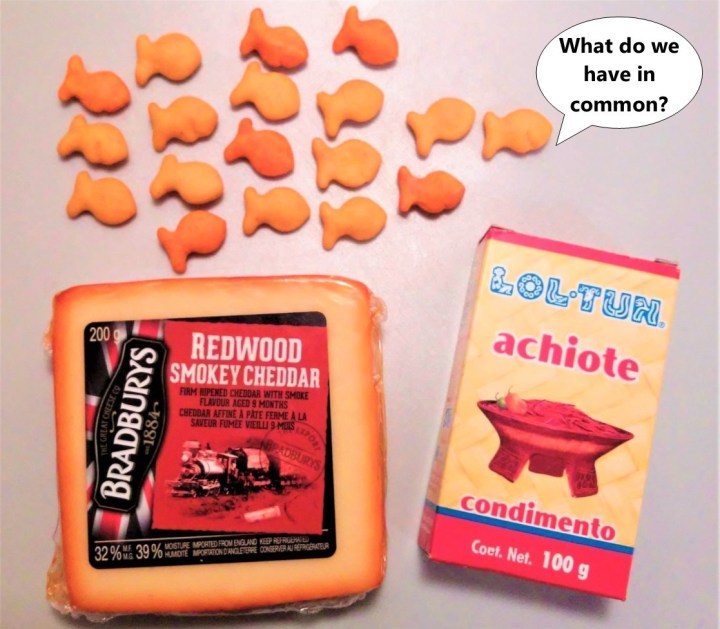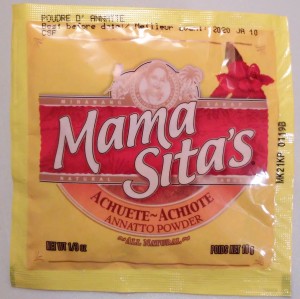
Annatto is a natural colorant and seasoning extracted from the dried seeds of an evergreen shrub, believed to have originated in the Brazilian Amazon, and then spread and developed as a crop up North, all the way to Southern Mexico (including Tabasco.) The Maya called it Kiwi’ but the Spaniards named it achiote, from the Nahuatl word axiotl. Annatto is the most common name around the world, adopted from a Carib language, while the plant’s scientific name, Bixa orellana comes from the word bija, or biché, another name given by Carib indigenous people, and after Francisco de Orellana, a Spanish explorer of the Amazon river. In pre-Hispanic times, annatto was mostly used as a dye for food, skin, fabrics and, along with cochineal, it was also used for manuscript painting, at least up to the sixteenth century. It is also documented that the Maya added annatto to their kakaw (cacao) drinks, practice that was followed by the Aztecs in their chocolatl, or cacahuatl (cacao water), and also by the Spaniards, who brought it to Europe, and continued to sing the praises and consume their annatto-tinted chocolate way into the 17th century (Red Velvet hot chocolate, anyone?)
 Spanish merchants introduced annatto to the Philippines (envelope of annatto powder from the Philippines, photo right), and from there, it quickly spread to Europe and the rest of Asia. For example, annatto has been a traditional colorant for Gloucester cheese since the 16th century; it was first added during the cold season, to simulate the natural carotene content in milk from the pasture eaten by the cows during the summer months. The trick later spread as a year-round practice, and also to other cheeses, such as Cheddar made in Scotland, and American cheese slices.
Spanish merchants introduced annatto to the Philippines (envelope of annatto powder from the Philippines, photo right), and from there, it quickly spread to Europe and the rest of Asia. For example, annatto has been a traditional colorant for Gloucester cheese since the 16th century; it was first added during the cold season, to simulate the natural carotene content in milk from the pasture eaten by the cows during the summer months. The trick later spread as a year-round practice, and also to other cheeses, such as Cheddar made in Scotland, and American cheese slices.
Nowadays, annatto is still used as a dye in many cosmetics, but especially as a natural food colorant. In addition to cheese, as seen on the photo at the top of the post, annatto may be found in baked goods, such as Gold Fish™ (AKA “fishy crackers”), and in Yucatan’s famous “recado rojo”, a red condiment prepared with annatto (achiote), herbs and spices, which is diluted in sour orange juice to use as a meat rub. The bright, almost radioactive, colour of annatto makes it more popular as a colorant, relative to its uses as a seasoning; however, when combined with other spices and herbs, annatto’s notes of nutmeg and pepper can become an exhilarating experience for the taste buds. The tabasqueña (from Tabasco) cuisine applies the use of annatto/achiote as a distinct condiment in many dishes, while providing an attractive orangey tint; one colourful example is the dough and filling of one of the many traditional tamales tabasqueños, called Chanchamitos:
 The recipe is not complicated, but requires several steps, so I will talk about the process, step by step, in my next post.
The recipe is not complicated, but requires several steps, so I will talk about the process, step by step, in my next post.








Interesting, I just learned something new. Thanks!
LikeLiked by 1 person
Thanks for your kind comment!
LikeLiked by 1 person
You are welcome!
LikeLiked by 1 person
Fascinating! Thanks for a cool post. It’s good to learn a little something : )
LikeLiked by 1 person
I am glad you liked it, Anna!
LikeLike
Great post! I have used annato a lot in cooking, and sometimes I just crush it and add it to oil. It creates such a beautiful color!
LikeLike
I bet it does! I have never seen the seeds, just the powder and the prepared “recado rojo” paste. I am posting the recipe for the tamales soon; they sure are beautifully coloured, too!
LikeLiked by 1 person
Your posts are all so interesting! The only information we get here about Mexico is about drug kartels and Trump’s wall. I love Mexican food but my husband refuses to go on vacation there, and Mexican restaurants are not very authentic.
LikeLiked by 1 person
I get very concerned about the situation in Mexico, too; that was one of the reasons to start my blog, to turn some attention to Mexico’s culture and some good news (like the trade deal and new president). I think it is ok to travel to Mexico, as long as you do your research of the places you would like to visit; I understand your husband’s apprehension, maybe you could get him to read my blog ;). It means a lot to me to learn that my posts are of interest; thank you so much for your kind comment, Stefan!
LikeLiked by 1 person
Neat, I learned something new, thanks for sharing.
LikeLike
I am glad you liked it Sheryl!
LikeLike
What a fascinating seed. To think I love Gloucester cheese and never knew Annatto gave it the colour. Funny that the maya called kiwi’ when the word usually refers to the bizarre bird in New Zealand or the green hairy fruit,
Wonderfully informative post. thank you for sharing it with me.
LikeLiked by 1 person